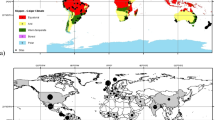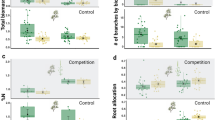Abstract
In Louisiana, salt marshes are being created in an effort to offset the large loss of such habitat that has occurred over the last 50 yr. Primary productivity is an important function and indicator of success for salt marsh creation and restoration projects. The aim of this study was to determine whether the aboveground and belowground productivity of the dominant salt marsh grassSpartina alterniflora in created marshes in southwest Louisiana began to approximate productivity levels in natural marshes, over time. Net annual aboveground primary productivity (NAPP) was measured by a harvest technique, while the ingrowth core method was used to estimate net annual belowground primary productivity (NBPP). NAPP levels were similar to those found in other, Louisiana salt marshes, while NBPP levels were similar to or higher than the reported range forS. alterniflora studied along the Atlantic and Gulf of Mexico coasts. NAPP tended to decrease as the created marshes aged, but the levels in the oldest, 19 year old, created marsh were still well above values measured in the, natural marshes. It was estimated that it would take 35 yr after marsh creation for NAPP in the created marshes to become equivalent to that in natural marshes. NBPP in the created marshes became equivalent to levels found in the natural marshes after 6–8 yr, but then belowground production increased with marsh age, reaching an asymptote that surpassed natural marsh levels. Equivalency in primary productivity has not been reached in these marshes. Elevation also affected productivity, as higher elevational sites with greater topographic heterogeneity had significantly lower aboveground and belowground biomass levels than those with elevations closer to mean sea level. This underscores the need to construct marshes so that their mean elevation and degree of topographic heterogeneity are similar to natural marshes.
Similar content being viewed by others
Literature Cited
Allen, T. F. H. andT. W. Hoekstra. 1992. Toward a Unified Ecology, 1st edition. Columbia University Press, New York.
Bertness, M. D. 1991. Zonation ofSpartina patens andSpartina alterniflora in a New England salt marsh.Ecology 72:138–148.
Blum, L. K. 1993.Spartina alterniflora root dynamics in a Virginia marsh.Marine Ecology Progress Series 102:169–178.
Boesch, D. F., M. N. Josselyn, A. J. Mehta, J. T. Morris, W. K. Nuttle, C. A. Simenstad, andD. J. P. Swift. 1994. Scientific assessment of coastal wetland loss, restoration and management in Louisiana.Journal of Coastal Research 20:1–103.
Bourne, J. 2000. Louisiana’s, vanishing wetlands: Going, going…Science 289:1860–1863.
Bradley, P. M. andJ. T. Morris. 1991. Relative importance of ion exclusion, secretion and accumulation inSpartina alterniflora Loisel.Journal of Experimental Botany 42:1525–1532.
Broome, S. W., E. D. Seneca, andW. W. Woodhouse, Jr. 1988. Tidal salt marsh restoration.Aquatic Botany 32:1–22.
Chabreck, R. H. 1989. Creation, restoration, and enhancement of marshes of the northcentral Gulf coast, p. 127–144.In J. A. Kusler and M. E. Kentula (eds.), Wetland Creation and Restoration: The Status of the Science. EPA 600/3-2-89/038a. U.S. Environmental Protection agency, Environmental Research Laboratory, Corvallis, Oregon.
Chabreck, R. H. 1994. Marsh management in Louisiana for production of emergent and aquatic plants. Report prepared for the Louisiana Landowners Association, Incorporated, Baton Rouge, Louisiana.
Craft, C. B., S. W. Broome, andE. D. Seneca. 1988. Nitrogen, phosphorus and organic carbon pools in natural and transplanted marsh soils.Estuaries 11:272–280.
Craft, C. B., J. M. Reader, J. N. Sacco, andS. W. Broome. 1999. Twenty-five years of ecosystem development of constructedSpartina alterniflora (Loisel) marshes.Ecological Applications 9:1405–1409.
Dawe, N. K., G. E. Bradfield, W. S. Boyd, D. E. C. Trethewey, andA. N. Zolbrod. 2000. Marsh creation in a northern Pacific estuary. Is thirteen years of monitoring vegetation dynamics enough?Conservation Ecology 4:12 [online] URL: <http: //www.consecol.org/vol4/iss2/art12.url>
Day, J. W., G. P. Shaffer, D. J. Reed, D. R. Cahoon, L. D. Britsch, andS. R. Hawes. 2001. Patterns and processes of wetland loss in coastal Louisiana are complex: A reply to Turner 2001. Estimating the indirect effects of hydrologic change on wetland loss: If the Earth is curved, then how would we know it?Estuaries 24:647–651.
Edwards, K. R. andC. E. Proffitt. 2003. Comparison of wetland structural characteristics between created and natural salt marshes in southwest Louisiana, USA.Wetlands 23:344–356.
Edwards, K. R., C. E. Proffitt, andS. E. Travis. 2001. Dieback inSpartina alterniflora marshes along the southwest Louisiana coast, p. 17.In R. E. Stewart, Jr., C. E. Proffitt, and T. M. Charron (eds.), Abstracts from “Coastal Marsh Dieback in the Northern Gulf of Mexico: Extent, Causes, Consequences, and Remedies.” Information and Technology Report USGS/BRD/ITR-2001-0003. U.S. Geological Survey, Biological Resources Division, Washington, D.C.
Egerova, J., C. E. Proffitt, andS. E. Travis. 2003. Facilitation of survival and growth ofBaccharis halimifolia L. bySpartina alterniflora Loisel. in a created Louisiana salt marsh.Wetlands 23:250–256.
Ellison, A. M., M. D. Bertness, andT. Miller. 1986. Seasonal patterns in the belowground biomass ofSpartina alterniflora (Gramineae) across a tidal gradient.American Journal of Botany 73:1548–1554
Finer, L. andJ. Laine. 2000. The ingrowth bag method in measuring root production on peatland sites.Scandinavian Journal of Forest Research 15:75–80
Gallagher, J. L. 1974. Sampling macro-organic matter profiles in salt marsh plant root zones.Soil Science Society of America Proceedings 38:154–155.
Gosselink, J. G. 1984. The ecology of delta marshes of coastal Louisiana: A community profile. FWS/OBS 84/09. U.S. Fish and Wildlife Service, Office of Biological Services, Washington, D.C.
Gosselink, J. G. 2001. Comments on “Wetland loss in the north ern Gulf of Mexico: Multiple working hypotheses” (R. E. Turner). 1997.Estuaries 20:1–13.)Estuaries 24:636–639.
Hopkinson, C. S., J. G. Gosselink, andR. T. Parrondo. 1980. Production of coastal Louisiana marsh plants calculated from phenometric techniques.Ecology 61:1091–1098.
Howes, B. L., J. W. H. Dacey, andJ. M. Teal. 1985. Annual carbon mineralization and belowground production ofSpartina alterniflora in a New England salt marsh.Ecology 66:595–605.
Hwang, Y. H. andJ. T. Morris. 1992. Fixation of inorganic carbon from different sources and its translocation inSpartina alterniflora Loisel.Aquatic Botany 43:137–147.
Kaswadji, R. F., J. G. Gosselink, andR. E. Turner. 1990. Estimation of primary production using five different methods in aSpartina alterniflora salt marsh.Wetlands Ecology and Management 1:57–64.
Kirby, C. J. andJ. G. Gosselink. 1976. Primary production in a Louisiana Gulf coastSpartina alterniflora marsh.Ecology 57: 1052–1059.
Landin, M. C., J. W. Webb, andP. L. Knudson. 1989. Long-term monitoring of eleven Corps of Engineers habitat development field sites built of dredged material, 1974–1987. Waterways Experimental Station Technical Report D-89-1, Waterways Experimental Station, Vicksburg, Mississippi.
Lomnicki, A., E. Bandola, andK. Jankowaska. 1968. Modification of the Wiegert-Evans method for estimation of net primary production.Ecology 49:147–149.
Mendelssohn, I. A. andJ. T. Morris. 2000. Ecophysiological controls on the growth ofSpartina alterniflora, p. 59–80.In N. P. Weinstein and D. A. Kreeger (eds.), Concepts and Controversies in Tidal Marsh Ecology. Kluwer, Dordrecht, The Netherlands.
Michener, W. K. 1997. Quantitatively evaluating restoration experiments: Research design, statistical analysis, and data management considerations.Restoration Ecology 5:324–337.
Mitsch, W. J. andJ. G. Gosselink. 2000. Wetlands, 3rd edition. Van Nostrand Reinhold Company, New York.
Molnar, Z. andZ. Botta-Dukat. 1998. Improved space-for-time substitution for hypothesis generation: Secondary grasslands with documented site history in SE Hungary.Phytoceonologia 28:1–29.
Morgan, P. A. andF. T. Short. 2002. Using functional trajectories to track constructed salt marsh development in the Great Bay Estuary, Marine/New Hampshire, U.S.A..Restoration Ecology 10:461–473.
Morris, J. T. andB. Haskin. 1990. A 5-yr record of aerial primary production and stand characteristics ofSpartina alterniflora.Ecology 71:2209–2217.
Morris, J. T., P. V. Sundareshwar, C. T. Nietch, B. Kjerfve, andD. R. Cahoon. 2002. Responses of coastal wetlands to rising sea level.Ecology 83:2869–2877.
Penland, S. 2001. Beneficial use of dredged material disposal history: Calcasieu River and pass, Louisiana U.S. Army Corps of Engineers, New Orleans, Louisiana.
Proffitt, C. E., S. E. Travis, andK. E. Edwards. 2003. Genotype and elevation influenceSpartina alterniflora colonization and growth in a created salt marsh.Ecological Applications 13: 180–192.
Proffitt, C. E. andJ. Young. 1999. Salt marsh plant colonization, growth and dominance on large mudflats created using dredged sediments, p. 218–228.In L. P. Rozas, J. A. Nyman, C. E. Proffitt, N. N. Rabalais, D. J. Reed, and R. E. Turner (eds.), Recent Research in Coastal Louisiana: Natural System Function and Response to Human Influence. Louisiana Sea Grant College Program, Baton Rouge, Louisiana.
Raynie, R. C., B. J. Miller, andW. K. Rhinehart. 2000. Coastal restoration division annual project reviews: December 2000. Louisiana Department of Natural Resources, Baton Rouge, Louisiana.
Roberts, D. W. 1987. A dynamical systems perspective on vegetation theory.Vegetatio 69:27–33.
Schubauer, J. P. andC. S. Hopkinson. 1984. Above-and below-ground emergent macrophyte production and turnover in a coastal marsh ecosystem, Georgia.Limnology and Oceanography 29:1052–1065.
Seliskar, D. M., J. L. Gallagher, D. M. Burdick, andL. A. Mutz. 2002. The regulation of ecosystem functions by ecotypic variation in the dominant plant: ASpartina alterniflora saltmarsh case study.Journal of Ecology 90:1–11.
Shew, D. M., R. A. Linthurst, andE. D. Seneca. 1981. Comparison of production computation methods in a southeastern North CarolinaSpartina alterniflora salt marsh.Estuaries 4: 97–109.
Short, F. T., D. M. Burdick, C. A. Short, R. C. Davis, andP. A. Morgan. 2000. Developing success criteria for restored eelgrass, salt marsh and mud flat habitatsEcological Engineering 15:239–252.
Simenstad, C. A. andR. M. Thom. 1996. Functional equivalency trajectories of the restored Gog-Le-Hi-Te estuarine wetland.Ecological Applications 6:38–56.
Steen, E. 1984. Variation of root growth in a grass ley studied with a mesh bag technique.Swedish Journal of Agricultural Research 14:93–97.
Steingrobe, B., H. Schmid, andN. Claassen. 2000. The use of the ingrowth core method for measuring root production of arable crops—Influence of soil conditions inside the ingrowth core on root growth.Journal of Plant Nutrition and Soil Science 163:617–622.
Stewart, R. E., C. E. Proffitt, and T. M. Charron (eds.). 2001. Abstracts from “Coastal Marsh Dieback in the Northern Gulf of Mexico: Extent, Causes, Consequences, and Remedies.” U.S. Geological Survey, Biological Resources Division, Information and Technology Report, USGS/BRD/ITR-2001-0003, Washington, D.C.
Streever, W. J. 2000.Spartina alterniflora marshes on dredged material: A critical review of the ongoing debate over success.Wetlands Ecology and Management 8:295–316.
SYSTAT. 2002. SYSTAT for Windows, version 10.2. SYSTAT Software, Inc., Richmond, California.
Travis, S. E., C. E. Proffitt, R. C. Lowenfeld, andT. W. Mitchell. 2002. A comparative assessment of genetic diversity among differently aged populations ofSpartina alterniflora on restored versus natural wetlands.Restoration Ecology 10:37–42.
Turner, R. E. 1997. Wetland loss in the northern Gulf of Mexico: Multiple working hypotheses.Estuaries 20:1–13.
Turner, R. E., E. M. Swenson, C. S. Milan, J. M. Lee, andT. A. Oswald. 2004. Below-ground biomass in healthy and impaired salt marshes.Ecological Research 19:29–35.
Valiela, I., J. M. Teal, andN. Y. Persson. 1976. Production and dynamics of experimentally enriched salt marsh vegetation: Belowground biomass.Limnology and Oceanography 21:245–252.
Vance, R. R., R. F. Ambrose, S. S. Anderson, S. MacNeil, T. McPherson, I. Beers, andT. W. Keeney. 2003. Effects of sewage sludge on the growth of potted salt marsh plants exposed to natural tidal inundation.Restoration Ecology 11:155–167.
Vogt, K. A., D. J. Vogt, andJ. Bloomfield 1998. Analysis of some direct and indirect methods for estimating root biomass and production of forests at an ecosystem level.Plant and Soil 200:71–89.
Webb, J. W. andC. J. Newling. 1985. Comparison of natural and man-made salt marshes in Galveston Bay complex, Texas.Wetlands 4:75–86.
White, D. A., T. E. Weiss, J. M. Trapani, andL. B. Thien. 1978. Productivity and decomposition of the dominant salt marsh plants in Louisiana.Ecology 59:751–759.
Wiegert, R. G. andF. C. Evans. 1964. Primary production and the disappearance of dead vegetation on an old field in southeastern Michigan.Ecology 45:49–63.
Zedler, J. B. andJ. C. Callaway. 1999. Tracking wetland restoration: Do mitigation sites follow desired trajectories?Restoration Ecology 7:69–73.
Zedler, J. B. andJ. C. Callaway. 2000. Evaluating the progress of engineered tidal wetlands.Ecological Engineering 15:211–225.
Sources of Unpublished Materials
Ford, M. personal observation. Coalition to Restore Coastal Louisiana, 746 Main Street, Suite B101, Baton Rouge, Louisiana 70802.
Author information
Authors and Affiliations
Corresponding author
Rights and permissions
About this article
Cite this article
Edwards, K.R., Mills, K.P. Aboveground and belowground productivity ofSpartina alterniflora (Smooth Cordgrass) in natural and created Louisiana salt marshes. Estuaries 28, 252–265 (2005). https://doi.org/10.1007/BF02732859
Received:
Revised:
Accepted:
Issue Date:
DOI: https://doi.org/10.1007/BF02732859




